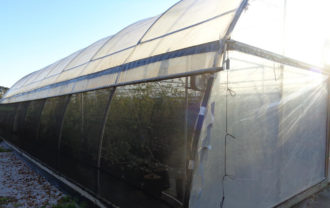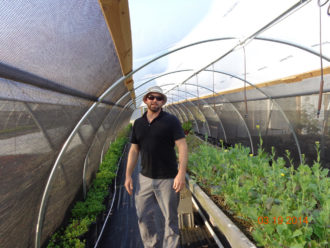GRIFFIN, Georgia – For producers seeking to reduce their pesticide applications, practice Integrated Pest Management, or transition to organic production, a new technology is emerging across the Southeast that allows farmers to more effectively manage pests in high tunnels.
A new bulletin, produced by Alabama Cooperative Extension and supported by the Southern Sustainable Agriculture Research & Education (SSARE) program, provides preliminary research data and field observations on shade cloths – a physical barrier that is designed to reduce pest pressure on vegetables and other crops.
“Some popular pest exclusion tactics include the use of floating row covers for protection against flying insects, bagging fruits, and installing metallic collars around transplants to protect them from cutworms and armyworms,” said bulletin author Ayanava Majumdar, an Alabama Cooperative Extension IPM specialist. “In these cases, a barrier is created between the insect pest and the host plant for short-term protection.”
With shade cloths, however, a more permanent barrier system is created around the high tunnels.
“Also known as net houses, these sealed structures, installed on the sidewalls and endwalls of a high tunnel, are designed to exclude pests while supporting beneficial insect populations,” said Majumdar, who also serves as a Southern SARE state ag coordinator for Alabama.
High Tunnel Pest Exclusion System: A novel strategy for organic crop production in the South, provides information on net house designs, cost effectiveness, system recommendations and research results on net houses, both in the lab and in the field.
In addition, the bulletin includes farmer experiences using net houses in Alabama. The information is provided, in part, through the results of a Southern SARE-funded Producer Grant (FS13-275), Insect Exclusion Using Woven Shade Cloth. Additional data is made possible through efforts associated with the Southern SARE Professional Development Program.
Majumdar said that the information in the bulletin is a starting point for growers interested in applying the technology on their farms. Research continues on the effectiveness of high tunnel pest exclusion systems with various other material and insect pests. For example, researchers are evaluating low tunnels for community gardens and urban farms were pest exclusion offers great benefits.
For more information, contact Ayanava Majumdar at bugdoctor@auburn.edu
--30--
Published by the Southern Region of the Sustainable Agriculture Research and Education (SARE) program. Funded by the USDA National Institute of Food and Agriculture (NIFA), Southern SARE operates under cooperative agreements with the University of Georgia, Fort Valley State University, and the Kerr Center for Sustainable Agriculture to offer competitive grants to advance sustainable agriculture in America's Southern region.

